FAQ
- What is the principal of a thermocouple?
- What is the advantage of using thermocouple probes?
- How many types does the thermocouple have?
- How to choose the model number?
- Heat resistance of cables and grips.
- How can I choose the most suitable model?
- What should I be careful when choosing a thermocouple temperature probe?
- What should I be careful when measuring surface temperature?
- Can I measure high temperature such as more than 800℃ (1472℉) with a contact temperature sensor probe?
What is the principal of a thermocouple?
Thermocouple temperature sensor utilise the principal of Seebeck effect. The Seebeck effect is a phenomenon that “when making a closed circuit with two dissimilar metals, electromotive force is produced if there is temperature difference between the two joints.”
However, the electromotive force is determined not by the temperature difference of the joints but by the temperature of each joint. Thus, the temperature of the joints cannot be determined only by the electromotive force.
Also, the joint contacting or being close to the object to be measured (=joint 1) is called a thermal bonding point and the other one (=joint 2) is a reference junction.
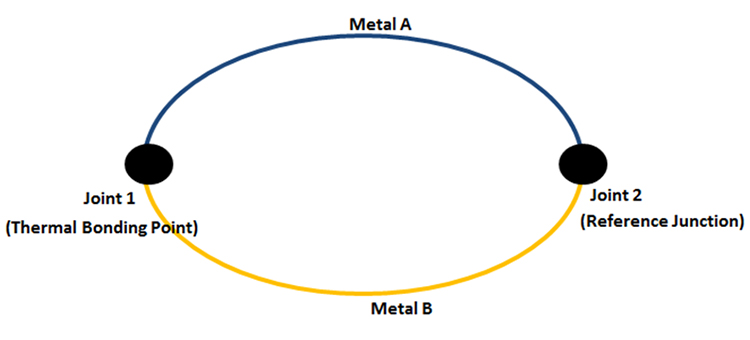
What is the advantage of using thermocouple probes?
You can varify the accuracy of your infrared thermometers by using contact thermocouple temperature sensor probes.Although infrared thermometers can measure only surface temperature, contact temperature sensor probes can measure any types of objects – Surface, internal, air, liquid or semi-liquid.
Customization is also easier than IR thermometers so you can find the one fits your application.As for Anritsu, you can build a customized probe from 1 pc minimum.
Besides that, thermocouple probes are more stable than infrared thermometers.When using infrared thermometers, the environment needs to be clean, without dust and high humidity because they are easiliy affected by that. Especially near ambient temperatures, readings may make an error because of the reflection of radiation from a hotter body—sometimes even the person holding the instrument.
As for contact probes, they are less affected by the use environment. Of course there are some conditions that contact probes cannot be used such as under extreme strong acids, but as long as the surface to be measured is clean, they can take measurement.
The last advantage is its easiness to use. Even though infrared thermometers need adjustments depending on the surface being measured before use, contact probes don't. You can take the measurement just by putting or inserting the probe on/in the objects for a few seconds '- No adjustment required.
By understanding the difference between the two and using contact temperature probes, you can take higher accuracy of temperature measurement.
How many types does the thermocouple have?
The most common types of thermocouples are K, E, J, T, R, B and S. The characteristics of each types are as follows;
| Type | Formerly known as | Combination |
|---|---|---|
| K | CA | Chromel–alumel |
| E | CRC | Chromel - constantan |
| J | IC | Iron - constantan |
| T | CC | Copper - constantan |
| R | (PR) | Platinum – 13% rhodium |
| B | - | Platinum 30% - 6% rhodium |
| S | - | Platinum - 10% rhodium |
Anritsu Meter manufactures E and K type as standard specifications because they are less expensive than R, B and S and deteriorate less in oxidizing atmospheres than J and T. Also, E and K have wide temperature range and can be utilised for varieties of applications.
How to choose the model number?
Anritsu's model numbers consist of 4 - 16 digits of numbers/alphabets.Each numbers and alphabets have meanings such as length of cable, temperature range.
For example, as for U series, the model number is as follows and each numbers/alphabets have different meanings
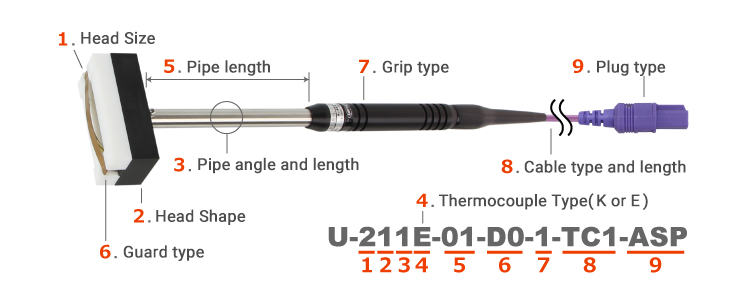
In other words, picking up the right model numbers is the very first step of the accurate measurement.If you are not sure the model number, please feel free to contact us.
Heat resistance of cables and grips
The temperature limit of each sensor is equal to the temperature limit of its head part.As for temperature limit of a grip and cord, please see the chart below. Using over the limit damages sensors. Also, please note well that under low temperature circumstance (minus temp.), sensors get frost on it and it reduces elasticity of the sensor and causes breakage.
| Part | Sign | Materials | Temp. Limit |
|---|---|---|---|
| Grip | See catalogue | Black phenolic resin | 200℃(392℉) |
| Polyacetal | 130℃(266℉) | ||
| Nylon resin | 130℃(266℉) | ||
| NF | Silicon | 240℃(464℉) | |
| K | Silicon | 240℃(464℉) | |
| Cord | TS | Silicon | 240℃(464℉) |
| TF | Teflon | 230℃(446℉) | |
| TC | Silicon | 240℃(464℉) | |
| TCG | Silicon with stainless shield | 240℃(464℉) | |
| SG | Glass fibre with stainless shield | 400℃(752℉) | |
| TPC | Polyurethane | 110℃(230℉) | |
| GW | Glass fibre | 300℃(572℉) |
How to choose the model number?
See this page or contact us.
What should I be careful when choosing a thermocouple temperature probe?
Thermocouple types of probes and thermometers should be same.If you choose K type thermocouple temperature sensor probe, the thermometer should be K type too.The same can be said to the plug types.
We offer mainly two types of the plugs - ANP and ASP.Please make sure the plug types of your thermometer and temperature sensor probe are same.
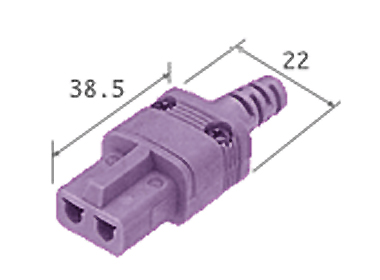
ANP
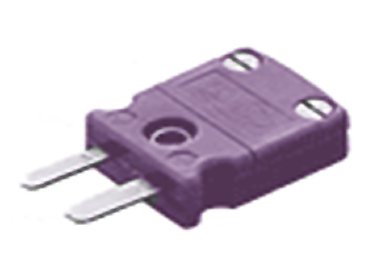
ASP
What should I be careful when measuring surface temperature?
Contact sensor probes measure their own temperature, so if the objects to be measured is too small, its heat will be taken by the probes too much and the results will be shown lower.
For example, if you measure a □4 x 5 millimetres aluminum block with a 10mm diameter probe, the block’s heat will be taken too much because the probe’s head is bigger than the block and the thermocouple doesn’t fully contact to the surface.
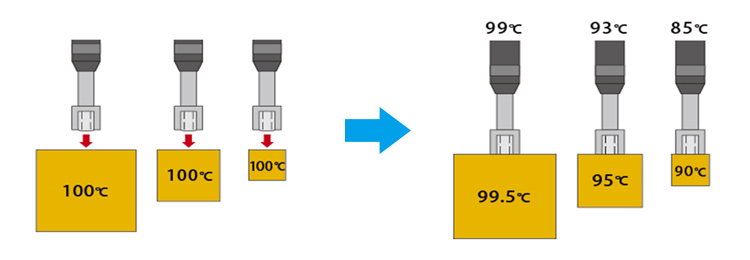
The next thing you need to be aware is to put the probe perpendicularly to the surface to be measured. This seems easy, but lots of people forget and fail. When measuring the surface temperature, make sure it contacts to the surface perpendicularly and there is nothing preventing the good contact between the thermocouple and the surface being measured.
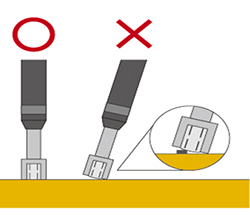
Can I measure high temperature such as more than 800℃ (1472℉) with a contact temperature sensor probe?
Yes, you can. HHT series measures up to 1100 C (2012 F)
